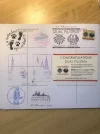I am seriously thinking to "hike" the Kumano Kodo in October/November next year, but one item holding me back is lodging or accommodation. I heard that they are expensive and also not many available along the trail as CF.
Any pointers will be appreciated.
Hi dfox,
I’d really recommend the Kumano! It was one of my favorite travelling experiences in all of Asia and a great way to see a side of Japan many visitors never experience.
A big part of that is the lodging, so definitely use the Tanabe tourism site to book as much of your accomadation as you can. Although it looks like a soulless electronic booking site, in fact it is mostly a way to connect foreigners with mom-and-pop lodgings; when you book, it sends an email to two lovely ladies at the Tanabe tourism desk (who you can meet in person when you go to pick up your stamp book) who call the lodgings, many of which are run by older couples who only speak Japanese and may not even use email, let alone internet booking. (Do this as far ahead as you can, because good lodgings fill up!) And always opt for dinner, breakfast, and box lunch, a Japanese-style room, and pick a place with a hotspring bath, if you can. The meals, which take advantage of seasonal local produce and are prepared in a multi-course Kaiseki style, often run for $100 USD or more at a restaurant, so to get it for breakfast and dinner along with a night in a traditional ryoukan (which itself can cost ~$200), all for around $100 is actually a really phenomenal deal! There are one or two hostels along the way (though they’re definitely not available in every town) but I would say, think of ryokans as an integral part of the Kumano experience. These lodgings are a once-in-a-lifetime thing (unless you go back, I guess.)
Kiri-no-Sato Takahara
Just off the trail, this small ryoukan is balanced on a hillside overlooking the town of Takahara. The food was phenomenal, and make sure to ask for a glass of their home-made umeshu (plum wine). There’s a lovely onsen bath and the bath, the dining room, and room balconies all have a great view of the valley below. Truly one of the most peaceful and soothing places I’ve ever been. I think I could stay here for a month.

www.kumano-travel.com
Guesthouse Okagesan
This is your chance to experience life in a traditional Japanese house, complete with an in-floor stove and rice-paper sliding walls, which once belonged to a famous local monk and writer (a relative of the current owner.) I think technically up to three guests can book it, but I had the whole house to myself- the owner lives in another part of the village. It’s more like an AirBnB than a hotel. It was my longest day on the Kumano (~30 Km, plus walking around the shrines of Hongu) and I got in quite late, around 9PM. I walked into the owner’s yakitori shop/bar- I think the entire village was there- and the whole bar toasted my safe arrival. No one spoke English and my Japanese isn’t great, but I could feel the exuberance. The owner came by the next morning with hot, fresh onigiri made with local fresh-caught fish, even though I didn’t order breakfast!

www.kumano-travel.com
OPTIONAL:
Minshuku Yunosato
This ryoukan is on the side of a river, and has an outdoor hotspring bath perched next to the bridge above it. The owner was really nice, and eating dinner, we could hear the sounds of her kids in the kitchen. There aren’t any shops to speak of in the town. Other than the bus that comes in the morning, it’s easy to forget that the outside world exists, especially when you’re walking on the cool river rocks (the water was around 3 feet at its deepest, in June) and looking up at the stars.

www.kumano-travel.com
OPTIONAL:
Nanki-Katsuura Kyukamura Resort
The perfect end to a long trek, this is an all-inclusive hotspring resort by the seaside, a short trainride north of the end of the trail, favored by families. I’ve been to a similar one in Gifu with local relatives, and it’s definitely a uniquely Japanese experience, though a very different vibe to the mom-and-pop ryoukans. The Kaiseki is about a million courses, I thought it was just an (excellent) buffet, but they kept bringing out more and more dishes! Steak, grilled shrimp, avocados stuffed with crab meat and cheese, delicate creations of rice flour, local seaweed salads, and of course fresh sashimi and grilled fish, my little table was filled with amazing food. The outdoor hotspring baths are numerous and are perched on cliffs overlooking the ocean, with hawks flying overhead. There are hiking trails to beaches and viewpoints throughout the National Park and a visitor center with incredibly friendly staff.

www.kumano-travel.com
The actual trail itself (if you follow the most well-documented route, the Nakahechi) is not all that strenuous, I think, compared to the Camino (from what I’ve heard.) I completed the bulk of it in 3 days (though I afforded 5 days total on the Nakahechi, plus one in Tanabe, one in Shingu/Kii-Katsura, and one at Kyukamura.) It’s got a lot of elevation gain but the distance isn’t that long; most people that I met averaged 15 Km/day, making the main section a comfortable 3-4 days. Definitely plan on extra days, though- the mountainous stone-and-mud paths aren’t just unpleasant in the rain, some are actually dangerous. Also, some people hike the last two sections (past Hongu down to Nachi Taisha), which will add about 2-3 days (including Nachi Taisha, which you should plan several hours for), but I opted to take a boat trip down the river to Shingu, partially because it’s what the original pilgrims did but mostly because the lodgings on that part of the trail were all full. Book early!
You’ll need some time in Tanabe, the staging city, to pick up your pilgrim’s passport at the Tourism Center and see the local temples (not to mention get their stamps!) Unlike the Camino, the stamps are not random- you have to collect particular ones in order to qualify, so you have to track them carefully and make sure you don’t miss stamp boxes (which are often 100-200 feet off the main trail, next to shrines- clearly marked by signs, but you have to keep track of which ones you need to go off to and which detours are optional). You can get a completion certificate for doing the basic ones, but if you get them all they give you an extra gift (the major and optional stamps are outlined in the stamp book). The first recommended leg (Takijiri-Oji to Takahara) is quite short, around 4Km with not much elevation, so I was able to do stuff in Tanabe in the morning, take the bus out to Takijiri-Oji, and do the two trails from there (for 2 optional stamps) before heading on to Takahara. The Takijiri-Oji gift shop/visitor center is well worth a stop, I bought a bamboo hiking stick that’s strong, flexible, and incredibly light; it was around $15 USD and the best hiking stick I’ve ever owned. In fact, I’m taking it with me to the Camino! A neck towel also doesn’t go amiss, it’s nice for wiping your face while walking.
On the other end, make sure to leave time (at least half a day) for the waterfall and temple complex at Nachi Taisha which has the “classic” view of the Kumano (the red shrine in front of the waterfall.) In Shingu, in addition to Hayatama Taisha, make sure to make time for Kamikura shrine, a short but steep walk up to a shrine next to a large boulder, a shrine even more ancient than the 3 Taishas (which are 2050 years old!)
I went in June of last year, which is supposed to be the rainy season, but I got lucky and avoided most of it- it rained the day before I left and the morning after I finished the trail it started pouring. As I said, though, rain can make the mountail trails impassible so it’s better to be safe than sorry.
Wow, that ended up being really long! Please let me know if you have any other questions.






















